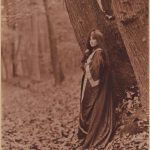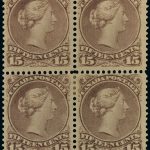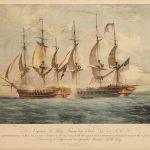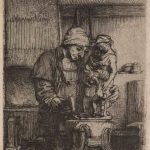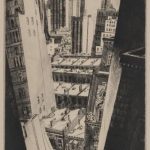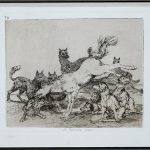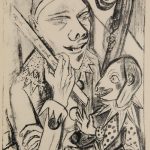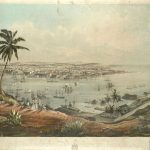Wove paper is defined as a paper having a cloth-like appearance when viewed by transmitted light (Roberts & Etherington, 1982, p. 284). In handmade paper, the finely woven wires in the papermaking mould achieved this quality. The mould was covered with a finely woven brass wire-cloth, which was referred to as brass vellum. This material was originally woven on a textile loom. James Whatman was likely to be the first to produce it in the western world, and John Baskerville was the first to use it in this work by Virgil. Reference: American Book Binders Museum.
Wove paper has been used for mounting photographs, lithographs and other prints including postage stamps. Below are some examples of prints on wove paper including a carbon print photograph and a drypoint print.
This haunting carbon print photograph of a woman in a forest is mounted on two two mounts, one cream light-weight wove paper and one beige medium-weight wove paper mount
Reference: Museum of Fine Arts Boston
1868-90 Ottawa Printing Medium to stout wove paper 15c. pale reddish purple, S.G.61a, block of 4, good colour, trace of the marginal marking at the foot, one stamp with a light gum crease, fresh, large part original gum. A SCARCE BLOCK IN VERY FINE CONDITION.
Sold for 504 GBP at Sotheby’s in 2011
This is one of four prints on wove paper, after John Christian, Schetky . They were made around 1830 The complete set, comprised of four lithographs with hand-coloring, published by Smith Elder & Co., with text and margins, framed.
They sold for US$ 956 (£ 778) inc. premium at Bonham’s in 2020
REMBRANDT HARMENSZ. VAN RIJN (1606-1669) The Goldsmith etching and drypoint, 1655, on thick laid paper, without watermark, a good but later impression of New Hollstein’s second state (of three), printing with a light plate-tone, with narrow margins, in very good condition; with two other prints by Rembrandt and seven after Rembrandt
Sold for GBP 2,375 at Christie’s in 2018
William Charles McNulty (1889-1963) THE WHIRLPOOL (IN THE FIFTIES) Drypoint, circa 1930, on wove paper, signed and titled in pencil, with good margins, framed. Plate 13 5/8 x 7 1/4 inches; 346 x 184 mm. Sheet 16 x 10 inches; 406 x 254 mm.
Sold for $562 (includes buyer’s premium)
Francisco Goya (Spanish, 1746–1828) etching, drypoint and burnished on wove paper. Plate 78 from the 80-piece series, ‘Los Desaastres de la Guerra’ (The Disasters of War). From the Se defiende bien, ‘He Defends Himself Well’
Sold for $150 at Grant Zahajko Auctions, LLC in 2020
